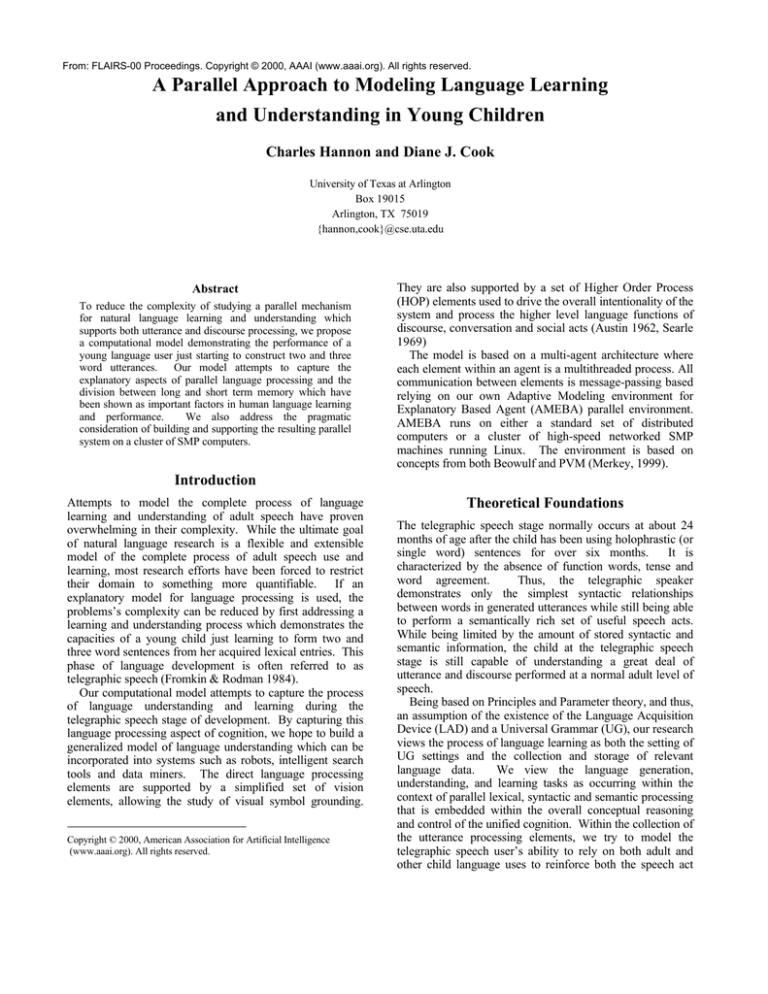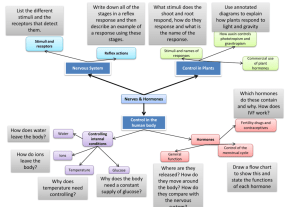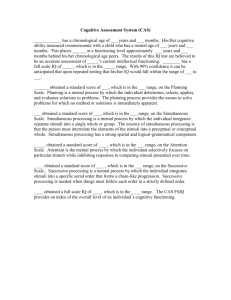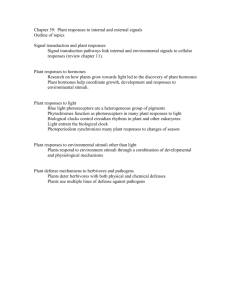
From: FLAIRS-00 Proceedings. Copyright © 2000, AAAI (www.aaai.org). All rights reserved.
A Parallel Approach to Modeling Language Learning
and Understanding in Young Children
Charles Hannon and Diane J. Cook
University of Texas at Arlington
Box 19015
Arlington, TX 75019
{hannon,cook}@cse.uta.edu
Abstract
To reduce the complexity of studying a parallel mechanism
for natural language learning and understanding which
supports both utterance and discourse processing, we propose
a computational model demonstrating the performance of a
young language user just starting to construct two and three
word utterances. Our model attempts to capture the
explanatory aspects of parallel language processing and the
division between long and short term memory which have
been shown as important factors in human language learning
and performance.
We also address the pragmatic
consideration of building and supporting the resulting parallel
system on a cluster of SMP computers.
They are also supported by a set of Higher Order Process
(HOP) elements used to drive the overall intentionality of the
system and process the higher level language functions of
discourse, conversation and social acts (Austin 1962, Searle
1969)
The model is based on a multi-agent architecture where
each element within an agent is a multithreaded process. All
communication between elements is message-passing based
relying on our own Adaptive Modeling environment for
Explanatory Based Agent (AMEBA) parallel environment.
AMEBA runs on either a standard set of distributed
computers or a cluster of high-speed networked SMP
machines running Linux. The environment is based on
concepts from both Beowulf and PVM (Merkey, 1999).
Introduction
Attempts to model the complete process of language
learning and understanding of adult speech have proven
overwhelming in their complexity. While the ultimate goal
of natural language research is a flexible and extensible
model of the complete process of adult speech use and
learning, most research efforts have been forced to restrict
their domain to something more quantifiable. If an
explanatory model for language processing is used, the
problems’s complexity can be reduced by first addressing a
learning and understanding process which demonstrates the
capacities of a young child just learning to form two and
three word sentences from her acquired lexical entries. This
phase of language development is often referred to as
telegraphic speech (Fromkin & Rodman 1984).
Our computational model attempts to capture the process
of language understanding and learning during the
telegraphic speech stage of development. By capturing this
language processing aspect of cognition, we hope to build a
generalized model of language understanding which can be
incorporated into systems such as robots, intelligent search
tools and data miners. The direct language processing
elements are supported by a simplified set of vision
elements, allowing the study of visual symbol grounding.
Copyright © 2000, American Association for Artificial Intelligence
(www.aaai.org). All rights reserved.
Theoretical Foundations
The telegraphic speech stage normally occurs at about 24
months of age after the child has been using holophrastic (or
single word) sentences for over six months.
It is
characterized by the absence of function words, tense and
word agreement.
Thus, the telegraphic speaker
demonstrates only the simplest syntactic relationships
between words in generated utterances while still being able
to perform a semantically rich set of useful speech acts.
While being limited by the amount of stored syntactic and
semantic information, the child at the telegraphic speech
stage is still capable of understanding a great deal of
utterance and discourse performed at a normal adult level of
speech.
Being based on Principles and Parameter theory, and thus,
an assumption of the existence of the Language Acquisition
Device (LAD) and a Universal Grammar (UG), our research
views the process of language learning as both the setting of
UG settings and the collection and storage of relevant
language data.
We view the language generation,
understanding, and learning tasks as occurring within the
context of parallel lexical, syntactic and semantic processing
that is embedded within the overall conceptual reasoning
and control of the unified cognition. Within the collection of
the utterance processing elements, we try to model the
telegraphic speech user’s ability to rely on both adult and
other child language uses to reinforce both the speech act
and general language performance both directly and
indirectly.
To study unified utterance and discourse understanding
and learning, our language model relies in both Jackendoff’s
model of conceptual reasoning and the discourse theories of
Speech and Conversation Acts. To study non-language
symbol grounding, it supports simple vision and concept
processing. The internal model of these processes is very
pragmatic; however we avoid obvious non-explanatory
reasoning methods by grounding these on cognitive
physiology research.
AMEBA Architecture
The AMEBA architecture represents the refinement of
generalized parallel tools to produce an environment for
testing cognitive theories. The architecture runs on a SMP
cluster using a Beowulf-like multiple high-speed networks.
It relies on a process control daemon running on each SMP
node to manage processes for a centralized set of X-window
user interfaces.
AMEBA provides an explanatory computational
architecture on which explanatory cognitive models can be
constructed and tested. In its computational architecture, it
attempts to capture the explanatory force of a connectionist
neural model while allowing the use of the better understood
representation and reasoning methods of symbolic AI. From
a system perspective, it provides processor transparency
within a parallel system and a flexible method of process and
knowledge management. The key element in the solution
of both of these sets of requirements is the etheron process
template shown in Figure 1. An etheron provides a
container for an instance of any inference or routing
mechanism needed by the system. Once contained, the
etheron supports the mechanism with, 1) a standard way to
load and store knowledge, 2) interfaces to AMEBA's
management tools and 3) a generalized set of
communication channels for talking with other etherons.
Etherons can be connected to each other in a lattice, like
the neurons in a neural network, but we have found it easier
to model agents using a tree structure. While they are
somewhat similar in design to an artificial neuron, etherons
function more like a neural analyzer, a sub-network in the
brain which serves a particular processing function
(Martindale 1991). Intra-agent communication between
etherons is defined using a set of stimulus messages. These
messages are defined in such a way as to reasonably
simulate the level of information being passed between real
neural analyzers within a collection of neural stimuli. The
inter-agent communication process is also based on message
passing, but the architecture leaves the details of the
message content up to the system designer.
Using AMEBA's management software, a user can
dynamically build a system of agents out of a set of
To Knowledge Tool
To System
(a parent
Etheron)
View/
Edit
System
Parent
To Control
Daemon
Control
Process/
Inference
Agent
Parent
To Agent
(a parent
Etheron)
To other
Etherons
Children
Trace
Listen for
connections
To Trace Tool
Figure 1. The Etheron
predefined etheron types and control the internal knowledge
loaded into each etheron during operation. Since etherons
support the ability to be started, stopped and moved
independently, the user can dynamically select which portion
of a parallel system to activate. Etherons are internally
multithreaded to take full advantage of a SMP host
processor. During the building of an etheron type, the
builder can use predefined inference methods or build a
special method for the particular task at hand. The AMEBA
libraries provide support for a temporal logic based
production system, a temporal-modal semantic network, a
back-propagation ANN, and a generic database lookup tool
built on top of PostgreSQL, an open-source ObjectRelational DBMS.
The Tallus Test System Design
Using AMEBA, we have constructed a Teacher Assisted
Language Learning and Understanding System (TALLUS)
consisting of a teacher agent and two student agents. The
current teacher agent only provides a text-based interface for
entering adult level utterances and capturing the telegraphic
speech level utterances of the students. The architecture of
one of the student agents is presented in Figure 2. Each
student agent is constructed from 20 etherons of six different
types. Since a student agent must glean enough information
out of an adult speech utterance.to learn and use telegraphic
speech, the majority of the language processing is dedicated
to understanding. One reason for picking the telegraphic
speech level to study is that the agent has to do very little to
the underlying semantic structure of an utterance to speak it.
Communication between agents TALLUS system uses
broadcast messages to simulate the language learning during
immersion.
TALLUS divides knowledge storage in the agent into
Long Term Memory (LTM) and Short Term Memory (STM)
storage (Baddeley 1987, Levine 1991). While being
strongly influenced by the Baddely & Hitch's
Social Knowledge Base
Ego Knowledge Base
Higher Order Processes Stimuli Router
A
g
e
n
t
Conversation Knowledge Base
Discourse Knowledge Base
Knowledge Stimuli Router
Episodic Reasoner
Semantic Concept Reasoner
Hearing
Interface
Utterance Stimuli Router
R
o
u
t
e
r
Semantics Reasoner
Syntactic Classifier
Lexicon Classifier
Vision
Interface
Vision Stimuli Router
Vision Classifier
Surface Structure Generator
Speaking
Interface
Speech Stimuli Router
Figure 2. A Student Agent in TALLUS
working memory model, the concept of STM is extended
past their phonological loop and visuo-spatial scratch-pad to
provide a seperate STM element in all three classifiers and
the Semantic Reasoner. We have been able to use a set of
three reasoners (a production system, semantic network, and
database based pattern matcher) for the Long Term Memory
(LTM) storage in all etherons. The Short Term Memory
(STM) elements of each etheron below the HOP processes
has been specialized.
The Vision Classifier is a simple simulation containing a
STM representation which functions much like a
conceptualized visuo-spatial scratch-pad.
The Lexical
Classifier uses a STM that closely reassembles a
phonological loop.
The Syntactic Classifier uses a stored set of flat (non-tree)
part-of-speech patterns to generate a governor and
government relationship for most non-function words in an
utterance. While it is based on Principle and Parameters
theory and can extract most information needed for
telegraphic speech, research has demonstrated the need to
move toward a more formal X-bar syntax. The Semantic
Reasoner uses the AMEBA's generic semantic network for
its LTM storage. The STM portion of this etheron creates
and maintains an activation list that supports such
explanatory concepts as priming and recall. All of the HOP
etherons use the AMEBA's generic production system for
both LTM (rules) and STM (facts) storage.
Information is passed between etherons in an agent using
stimuli messages. Since the goal of an etheron network is to
emulate a collection of neural analyzers, stimuli messages
have been kept as simple as possible. The basic structure of
a stimulus is:
[x]STN(parameter[0], parameter[1], ... parameter[n])
where x is an optional modifier and STN is a three letter
stimuli type name. AMEBA’s communication API takes
care of encoding and decoding the parameter list but
enforces no semantic structure on the list,leaving this to the
sending and receiving etheron. For example, in TALLUS, a
TAG stimuli type is used to tag an input word with its
speaker and the order in which it is received, and a POS
stimuli type is used to assign a part-of-speech to a tagged
word. All etherons in the language sub-network know how
to extract the information encoded in both of these stimuli
types to do their particular task.
By using the modifier field of a stimuli type, additional
semantics are added to a stimuli type's meaning. For
example, an unmodified POS stimuli is always interpreted as
a positive assertion about the part-of-speech of a word. If an
etheron cannot absolutely assert the part-of-speech of a
tagged word, but has evidence that it might be some part-ofspeech, it can send a *POS stimulus which is interpreted as
a positive hypothesis about the contents of the POS stimulus.
If it has evidence that a certain tagged word cannot be some
part-of-speech, it can send a !POS stimulus which is
interpreted as a negative hypothesis about the contents of the
POS stimulus. A ?POS stimulus is used to ask a question
about the truth of contents of a POS stimulus.
As words arrive at the Agent Interface, they are converted
to TAG stimuli and these stimuli are broadcast to all
etherons directly connected to the Utterance Stimuli Router
(the green colored etherons in Figure 2). After the TAG
message is sent, the resulting processing becomes highly
parallel. While the Lexical Classifier is trying to create a
POS stimulus for the word, the Syntactic Classifier is trying
Results
Currently TALLUS demonstrates, 1) an understanding of
telegraphic language at both the utterance and discourse
level, 2) the ability to associate an input utterance to its
visual environment and 3) the learning of concepts and
language at the utterance level. TALLUS operates on a
SMP cluster of 16 total processors and two redundant single
processor servers. The topology of this system is eight twoprocessor SMP machines connected via two switched and
one hubbed 100baseT networks.
While improving speedup performance is not the major
focus of our current research, AMEBA relies on the ability
to distribute large cognitive models across a number of
computers. Figure 3 presents the results of a set of speedup
tests conducted on 1 to 5 two-processor SMP nodes. The
system was first divided across agent boundaries, and then,
each Student agent was divided across two SMP machines.
The tests were connected using two network topologies, one
with 100MB/sec and one with 500MB/sec effective
throughput.
Speedup
to construct sentences out of the input words and relate these
words to the part-of-speech information retrieved by the
Lexical Classifier. Even before the POS message gets to the
Syntactic Classifier so it can generate a SYN (syntax)
stimulus to send to the Semantic Reasoner, the Semantic
Reasoner is activating the word nodes in its LTM and
starting to generate the SEM (semantic) stimuli it will
broadcast to the HOPs and vision system based on the total
utterance. At the HOPs, these SEM stimuli are being
matched with each other and the REF (reference) stimuli
being generated by the vision sub-network to fire rules of
discourse, socialization and planning which determine both
the response needed and how this response should be carried
out.
Learning in our system is incorporated as part of each
etheron's normal knowledge processing, and not as any
separate or distinct machine learning algorithm. Utterance
level learning occurs when a higher level system is able to
feed-back a hypothesis it used in place of the data it would
normally receive from an input level system. For example,
both the Syntactic Classifier and Semantic Reasoner use
part-of-speech information to complete their task. If the
Lexical Classifier is unable to send a POS stimulus, the
Syntactic Classifier and Semantic Reasoner try to figure out
the part-of-speech of a word by context. These hypotheses
are then fed back to the Lexical Classifier which either adds
a new part-of-speech record to its LTM or modifies its
confidence in a record. Records that fall below a certain
confidence level are removed from the LTM all together.
AMEBA also supports the dynamic modifiication of a
production system's rules (i.e., live experts) which we will
be using in the future for discourse level learning.
6
5.5
5
4.5
4
3.5
3
2.5
2
1.5
1
100MB/sec
500MB/sec
Linear
1
2
3
4
5
Number of Nodes
Figure 3. TALLUS Performance
The reported results represent the average trial time of the
values that clustered around the median time of test. This
method was used instead of a straight average since some
evaluation tests took as much as three times as long as the
median. While access to the high-speed networks being
used to link our SMP cluster is carefully controlled, it is
suspected that some of these longer test times were a result
of network interference caused by utility messages within the
network. While not providing anything close to linear
speedup, these results show that AMEBA’s speedup is well
within the expected range of such a course grain
parallelization method.
As a brief example of the system's language understanding
performance, take the simple teacher input utterance; "What
is this?" [spoken with the scene database containing the
representation, item0 (the teacher) contains item4 (a blue
ball)]. To further simplify, we will assume that all utterance
level etherons already have the knowledge to process this
sentence so that no learning is required.
Given this text input, the Agent Interface receives and
tags the words and the Lexicon Classifier creates three partof-speech stimuli for them. The Syntax Classifier uses this
information to look up the phrase template and generates
two syntax stimuli that state; 'in sentence 1, word 1 is the
subject and word 3 is the object of word 2'. Using all of
this, the Semantic Reasoner first activates all possible
meanings of the three words, and then, uses the syntactic
information to reduce the 'is' to the equative (or linking)
form and the 'this' to a grounding marker. It then generates
two semantic stimuli that state; 'in sentence 1, the teacher
requests the name of ground marker1 and the teacher
contains ground marker1'.
The semantic stimuli cause the Ego HOP to generate a
stimuli stating 'for sentence 1, I want to answer'. The
semantic stimuli causes the social HOP to generate a stimuli
stating 'for sentence 1, I should answer' since the teacher has
not told them to be quiet. The Conversation HOP generates
a stimuli indicating the agent has the turn. Using all of this,
the Discourse HOP generates a reference question stimuli
asking; 'regarding sentence 1, how can the statement, teacher
contains ground marker1, be resolved'.
The Vision
Classifier then looks in the scene to see that the teacher
contains item4. If it has a correct symbol name for item4, it
returns two reference stimuli that state 'regarding sentence 1,
the teacher contains ball and blue is the color of ball'. The
Discourse HOP then generates three action stimuli that state;
'activate teacher, activate ball in reference to teacher, and
activate blue in reference to ball'. These action stimuli are
used by the Semantic Reasoner to generate two response
stimuli that are sent to Agent Interface. Using these the
Agent Interface speaks; "blue ball". If the Vision Classifier
has no reference for item4, no output is generated but the
HOPs start listening for the other student or teacher to give
the answer. Once the answer is confirmed by the teacher,
the student updates its knowledge (i.e. learns) that item4 is a
blue ball.
As an example of the system's learning performance, take
a set of input utterances containing the word ‘ball’ where the
agent starts with no information about the word. When a
sentence with ‘ball’ is received, the Lexicon Classifier
creates part-of-speech stimuli for the known words. The
Syntax Classifier looks up all patterns that match the phrase
length and known part-of-speech slots and generates a
positive hypothesis about the missing part-of-speech. This
positive hypothesis would then cause the Lexicon Classifier
to begin creating a belief that `ball' is a noun.
Given enough examples of `ball' filling a noun position,
the Lexicon Classifier's belief grows to the point that it will
assert that `ball' is a noun when stimulated by a tag stimulus.
Now that the part-of-speech of `ball' is known, the Semantic
Reasoner will try to activate the semantic concept `ballnoun' from an input sentence but will fail because it does not
exist. This causes the Semantic Reasoner to create a new
node for `ball-noun' and link it, with a minimum level of
belief, to the concept `physical-object' since it, like
`physical-object', is capable of having a color. As the
concept `ball-noun' is used in other contexts, additional
semantic and conceptual links are formed.
Learning new phrase patterns and syntactic roles is
similar to the word learning process but is too complex to
describe here. The current system uses a non-tree approach
that has proven to not scale. It is being replaced with a
method which relies directly on X-bar syntax.
Future Work
Clearly, the current work with TALLUS can be extended to
gain a further understanding of both the language processing
and its impact on a broader unified model of cognition.
AMEBA is designed to allow cognitive models to be further
and further refined. Our current ability to model discourse
processing, general vision, and higher order processes needs
to be both broadened and refined. While TALLUS is the
major focus of our research with AMEBA, we are also
working on other more detailed models of more well defined
cognitive tasks. As expected, these systems have already
pointed out several minor weaknesses in TALLUS which
need to be addressed. It is this interplay of models which we
hope will allow AMEBA to contribute to the overall field of
cognitive science.
The next detailed modeling domain we plan to address is
the Wisconsin Card Sorting Test (WCST). The WCST will
provide an opportunity to study such things as mental sets
and task planning. The results of this model will then be
feedback into TALLUS.
Conclusion
TALLUS has supplied both insight into parallel language
processing and the possibilities of unified model of
cognition. It is probably best for cognitive scientists to view
unified cognitive modeling like physicists view controlled
nuclear fusion. It may not be something we will see in our
lifetime, but it will not invent itself. Using AMEBA to
generate models like TALLUS, and then, combining the
results of these models into an unified whole may be one
way to approach such a formidable task.
TALLUS shows that it is possible to build a cognitive
model of language learning and understanding that can be
examined symbolically. As both AMEBA and TALLUS
mature, TALLUS should both continue to improve our
understanding of the cognitive processes of language
learning and understanding and serve as model of
applications applying these understandings.
References
Anderson, J. R. 1995. Cognitive Psychology and its
Implications. New York: W. H. Freeman and Company.
Austin J. L. 1962. How to do things with words. Boston:
Harvard University Press.
Baddeley, A. D. 1987. Working Memory. London: Oxford
University Press.
Fromkin, V. and R. Rodman 1988. An Introduction to
Language. Fort Worth, TX: Holt, Rinehart and Winston,
Inc.
Haegeman, L. 1991. Introduction to Government and
Binding Theory. Oxford, UK: Blackwell.
Martindale, C. 1991. Cognitive Psychology, A NeuralNetwork Approach. Brooks/Cole Publishing Co., Pacific
Grove, CA.
Levine, D. S. 1991. Introduction to Neural and Cognitive
Modeling. Hillsdale, NJ: LEA, Inc,.
Searle, J. R. 1969. Speech Acts: an essay in the philosophy
of language. London: Oxford University Press.





